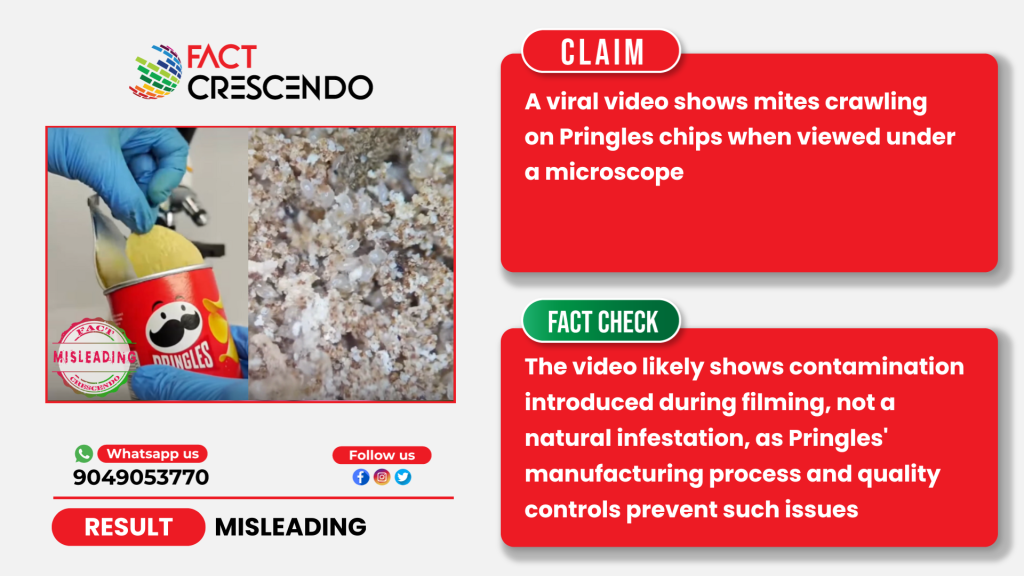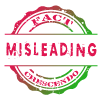
A viral video has been circulating on social media. showing what looks like tiny white mites crawling on a Pringles chip under a microscope. The video begins with an individual opening a Pringles can, placing a chip under a microscope, and revealing numerous small creatures crawling on its surface. This content has sparked significant concern among consumers regarding the safety and hygiene of this snack brand.
Social Media Posts
Multiple social media users shared a video that appeared to show mites crawling on Pringles chips when viewed under a microscope. The video spread rapidly across Facebook, X, and TikTok. The video post on X has gained over 4 million views so far.
Fact Check
Upon closer examination, several factors suggest that the video may not depict a genuine, naturally occurring infestation:
Hygiene Concerns in Video Production: The video surrounding shows dirty gloves and an unclean setting, which are signs of poor hygiene that raise concerns about contamination. These unsanitary conditions likely introduced contaminants, including mites, onto the chip during filming.
Staging Indicators: The video does not provide continuous footage linking the unaltered chip to the microscopic view, leaving room for potential manipulation. It’s plausible that the mites shown were introduced onto the chip intentionally or that the magnified footage was from a different source altogether.
Environmental Conditions: Mold mites, the type of creatures likely depicted, thrive in moist, moldy environments. Pringles chips, however, are manufactured to be dry and are sealed in packaging designed to prevent moisture ingress. For such an infestation to occur naturally, the chips would need to be exposed to significant humidity and mold growth, conditions highly unlikely in properly stored products.
Pringles Standards
Pringles adheres to stringent food safety regulations to ensure product quality and prevent contamination. In the United States, the Food and Drug Administration (FDA) regulates snack manufacturers like Pringles, enforcing compliance with hygiene standards, ingredient safety, and best manufacturing practices.
Pringles have a unique production process that minimizes the risk of contamination. Pringles are made from a dough created from dried potato flakes, unlike traditional potato chips, which are made from raw potato slices.This dough is shaped, cut, and fried at high temperatures, resulting in a product with very low moisture content. The dry environment makes it highly unlikely for mold or mites to survive or reproduce.
The production process at Pringles includes quality control procedures. These involve checking ingredients, monitoring production, and inspecting finished products before packaging. These measures are designed to maintain product standards (Source: Mashed). So, it is highly unlikely that Pringles could be naturally infested with mites, as suggested in the viral video, given these measures.
Furthermore, We have reached out to Pringles for clarification on this matter and will update this article once we receive their response.
Food Mite Behavior and Storage Conditions
According to Colonial Pest Control, food mites typically appear in environments with high moisture and mold levels. These pests primarily infest long-stored food items that have deteriorated. They’re most commonly found in damp storage areas like basements or garages, particularly in items such as pet food and bird seed that have been left unused for extended periods.
Furthermore, a study in Veterinary Sciences found that storage mites, particularly Tyrophagus putrescentiae, thrive on protein- and fat-rich dog foods, especially when there’s high initial mite density and crushed kibbles. Storage mites enter through defective seals rather than boring holes. Although newly-opened foods kept at moderate temperatures rarely experience mite contamination, products stored in hot and humid conditions may develop mite infestations even in sealed packaging.
These findings underscore the importance of proper storage conditions in preventing mite infestations. Maintaining low humidity, ensuring cleanliness, and storing food products in sealed containers in cool, dry environments are essential to take important steps to reduce the risk of contamination.
Additional Findings
The YouTube channel, BITGER, has examined the viral videos claiming to show mites in Pringles. Through split-screen comparisons and detailed footage, the creator demonstrates the contrast between clean and infested chips. The creator clearly states that the mites were placed on the chip for educational purposes to show how moisture and mold create conditions for mite infestations.
A separate video from a year ago shows a microscopic view of Pringles chips. This microscopic examination shows the chip’s surface structure and composition, and contains no visible mites, which aligns with expectations for properly stored Pringles products.
Conclusion
Our investigation found no credible evidence that Pringles chips naturally contain mites. The video likely misrepresents reality, as Pringles’ strict manufacturing controls, food safety protocols, and other microscope examinations suggest the contamination was deliberately introduced during filming.

Title:Fact Check: Viral Video of Mites on Pringles Chips is Misleading
Fact Check By: Cielito WangResult: Misleading


